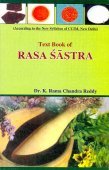Rasaparpati, Rasaparpaṭī, Rasa-parpati: 3 definitions
Introduction:
Rasaparpati means something in Hinduism, Sanskrit. If you want to know the exact meaning, history, etymology or English translation of this term then check out the descriptions on this page. Add your comment or reference to a book if you want to contribute to this summary article.
In Hinduism
Ayurveda (science of life)
Rasashastra (Alchemy and Herbo-Mineral preparations)
Source: Wisdom Library: Rasa-śāstraRasaparpaṭī (रसपर्पटी) refers to a type of Parpati medicine, according to the fourth volume of the Rasajalanidhi (chapter 3, grahaṇī: chronic diarrhoea).—Accordingly, “equal quantities of mercury and sulphur are to be rubbed together to form a kajjali or black powder, which is to be melted in an iron ladle placed upon fire, made of char coal (prepared preferably from wood of badara), and devoid of smoke. While melting the kajjali is to be rolled by means of a stick, so long as the former does not completely melt. It is then to be thrown forthwith upon a banana leaf, placed upon a small dais made of cow-dung, and pressed immediately by means of a lump of cow-dung contained in another piece of a banana leaf, external surfaces of the two leaves being smeared with a little of clarified butter. By this pressure, the melted kajjali will become very thin and widened. This is called parpati. The whole of the kajjali may thus be transformed into parpati, which is next to be smeared with a little of clarified butter and heated by a very mild heat, for a few minutes”.
Rasaparpaṭī cures piles, grahani, colic, diarrhoea, jaundice, anemia, enlargement of spleen, gulma, dropsy, bhasmakagni (abnormal hunger), ascites, leprosy, amlapitta, and many other diseases.

Āyurveda (आयुर्वेद, ayurveda) is a branch of Indian science dealing with medicine, herbalism, taxology, anatomy, surgery, alchemy and related topics. Traditional practice of Āyurveda in ancient India dates back to at least the first millenium BC. Literature is commonly written in Sanskrit using various poetic metres.
Languages of India and abroad
Sanskrit dictionary
Source: Cologne Digital Sanskrit Dictionaries: Monier-Williams Sanskrit-English DictionaryRasaparpaṭī (रसपर्पटी):—[=rasa-parpaṭī] [from rasa > ras] f. a [particular] preparation of mercury, [Bhāvaprakāśa]
[Sanskrit to German]
Sanskrit, also spelled संस्कृतम् (saṃskṛtam), is an ancient language of India commonly seen as the grandmother of the Indo-European language family (even English!). Closely allied with Prakrit and Pali, Sanskrit is more exhaustive in both grammar and terms and has the most extensive collection of literature in the world, greatly surpassing its sister-languages Greek and Latin.
See also (Relevant definitions)
Partial matches: Parpati, Rasa, Raca.
Full-text: Rasendraparpati, Svarnaparpati, Vajraparpati, Sutendraparpati, Lauhaparpati, Pancamritaparpati, Vijayaparpati, Pancamrita.
Relevant text
Search found 2 books and stories containing Rasaparpati, Rasa-parpati, Rasa-parpaṭī, Rasaparpaṭī; (plurals include: Rasaparpatis, parpatis, parpaṭīs, Rasaparpaṭīs). You can also click to the full overview containing English textual excerpts. Below are direct links for the most relevant articles:
Rasa Jala Nidhi, vol 4: Iatrochemistry (by Bhudeb Mookerjee)
Part 84 - Vajra-parpati < [Chapter III - Jvaratisara fever with diarrhoea]
Part 77 - Rasendra parpati < [Chapter III - Jvaratisara fever with diarrhoea]
Part 83 - Vijaya-parpati < [Chapter III - Jvaratisara fever with diarrhoea]
Rasa Jala Nidhi, vol 5: Treatment of various afflictions (by Bhudeb Mookerjee)
Related products
